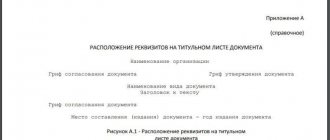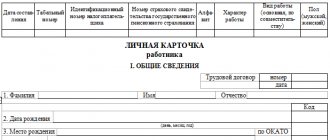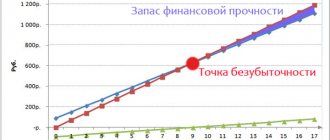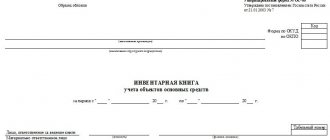The schedule for the implementation of professional standards is mandatory for state and municipal organizations, as well as enterprises belonging to them. What are the specifics of its compilation?
What is the schedule for implementing professional standards in an organization?
What is included in the action plan for the implementation of professional standards?
Schedule for implementation of professional standards: document structure
Results
What is the schedule for implementing professional standards in an organization?
A professional standard is a set of qualification criteria that an employee of an enterprise needs to carry out his professional activities and perform the labor function provided for by the contract (Article 195.1 of the Labor Code of the Russian Federation). Professional standards are developed by competent government departments in the manner established by the Government of the Russian Federation (Article 195.2 of the Labor Code of the Russian Federation).
It is mandatory to use professional standards:
- state and municipal structures (clause 1 of the Decree of the Government of the Russian Federation dated June 27, 2016 No. 584);
- enterprises that are more than 50% owned by these structures (clause 1 of Resolution No. 584);
- private firms that have jobs, the presence of which predetermines the need to provide employees with benefits and preferences guaranteed by the legislation of the Russian Federation (Article 57 of the Labor Code of the Russian Federation).
The procedure for applying professional standards is also established by the federal authorities.
Introduction of professional standards at enterprises in the private sector: nuances
In turn, professional standards in the private sector are mandatory only if, as we noted above, this is prescribed by federal regulations. At the same time, employers are obliged to use the relevant standards in any case when determining the requirements for the level of qualifications of employees, taking into account the specifics of the organization of production (Article 195.3 of the Labor Code of the Russian Federation).
If we talk about the requirements of federal regulations regarding the mandatory application of professional standards in private companies, so far there are 2 similar industry-wide standards in force at the appropriate level:
- employers who have jobs with benefits or restrictions on working conditions must determine the names of the positions corresponding to them, as well as establish requirements for the qualifications of employees based on professional standards (Article 57, Article 195.3 of the Labor Code of the Russian Federation);
- if occupational safety requirements are specified in professional standards, the employer is obliged to provide appropriate training to employees, i.e., in practice, to fulfill the requirements of professional standards (Article 212 of the Labor Code of the Russian Federation).
Private firms develop the procedure for implementing professional standards independently. However, nothing prevents their management from implementing this procedure based on the algorithms proposed by the legislator for state and municipal structures - they are quite applicable to business entities with any legal status.
Let us consider what specific events can form the appropriate order.
What is included in the action plan for the implementation of professional standards?
It is worth noting that the Government of the Russian Federation has currently developed only 1 regulatory document regulating the procedure for applying professional standards by organizations.
Thus, by Decree of the Government of the Russian Federation dated June 27, 2016 No. 584, an obligation was introduced for state and municipal structures (including enterprises in which more than 50% of the share belongs to the authorities) to draw up special plans for the implementation of professional standards in organizations .
The relevant documents must contain, first of all, lists of professional standards that are subject to application in the organization, as well as information about the stages of their practical implementation.
In addition, the action plans for the implementation of professional standards (also informally called “plans and schedules”) record the organization’s need to conduct training for employees in order to ensure that their qualifications meet the criteria set out in the professional standards.
The schedules under consideration should also reflect lists of local standards and other documents of the organization (relating, in particular, to issues of certification and other forms of assessing the competence of employees), which should be changed based on the criteria established in professional standards.
Organizations need to implement the activities reflected in the schedule by 01/01/2020.
If we consider the Decree of the Government of the Russian Federation No. 584 as a legal analogy from the point of view of its applicability by private enterprises that do not belong more than 50% to the state or municipalities, but are obliged to use professional standards (due to the presence of “harmful” jobs), then it would be legitimate to talk about the possibility of drawing up a schedule for the implementation of professional standards at the enterprise in a structure based on the provisions of the relevant resolution.
Let's consider what such a schedule might look like.
Professional standards: what to do by July 1 to avoid fines
Anna VASENINA, publisher of the magazine “Personnel Business”, member of the Council for Professional Qualifications in the Field of Personnel Management of the National Council under the President of the Russian Federation for Professional Qualifications
In the article read:
How to find out for which positions professional standards are required
How to rename positions and make changes to employment contracts
How to develop a work plan based on the results of the implementation of professional standards
Why all the fuss?
From July 1, 2020, Article 195.3 of the Labor Code on the procedure for applying professional standards comes into force (Law of May 2, 2020 No. 122-FZ). Until this time, you need to create a working group and find out which professional standards are mandatory for you and which are not. If the company has positions for which standards are mandatory, move on to implementation. If there are no such positions, decide whether to apply professional standards or not. What exactly should you do to calmly leave work on the evening of June 30 and not worry about fines? Arm yourself with a cheat sheet. Let us analyze the employer’s actions step by step and explain them with examples.
What does it mean to apply professional standards?
Applying professional standards means taking their requirements into account when hiring, developing local regulations, certifying and training employees. The law does not provide specific guidance in this regard. Employers determine the procedure independently (Article 8 of the Labor Code of the Russian Federation). Professional standards can be introduced gradually, but before July 1 of this year, carry out a number of activities.
Step 1: Create a working group
So, the management of your company has decided to determine job titles and qualification requirements for employees taking into account professional standards. Moreover, the released professional standards will be implemented for all positions, and not just for those for which they are mandatory.
They entrust the implementation of professional standards to a special working group. Issue an order, determine the composition and powers of the members of the working group, and appoint a leader. A sample order is posted below. Include competent employees from structural divisions, personnel services, accounting, and legal departments in the group. Familiarize the interested employees with the order against signature.
Download and print the sample
Stage 2. Develop and approve a work plan for the implementation of professional standards in the organization
The working group is drawing up a plan for the implementation of professional standards. Fix in it the directions of work, deadlines for their completion, responsible persons, and criteria for achieving results. A sample plan is posted below.
Download and print the sample
Responsibility for non-application of professional standards
If professional standards are mandatory, but you do not apply them, the GIT will hold you accountable. The punishment may be (part one of Article 5.27 of the Code of Administrative Offenses of the Russian Federation): – warning; – a fine for officials in the amount of 1,000 to 5,000 rubles, for legal entities – from 30,000 to 50,000 rubles. Professional standards are mandatory in two cases: – if the position provides compensation, benefits or restrictions are established (paragraph 3, part two, article 57 of the Labor Code of the Russian Federation); – if the legislation establishes mandatory requirements for the qualifications of an employee (Article 195.3 of the Labor Code of the Russian Federation). Read about the administrative liability of an employer in the article “When an employer can be held administratively liable.”
Stage 3. Implement the activities provided for in the plan
At the next stage, proceed to the implementation of the activities provided for in the plan. Let's explain each step.
Step 1. Find out for which positions professional standards are required
All employers must apply professional standards in two cases. Firstly, when a specific position provides compensation and benefits or restrictions. In such a situation, the names of positions, professions, specialties and qualification requirements must comply with professional standards or qualification reference books (part two of Article 57 of the Labor Code of the Russian Federation). If the names of positions and professions are contained in both reference books and professional standards, the employer himself chooses what to follow. The exception is when the law directly states what to apply.
Example
Work in the profession of “track fitter” in the metro is included in the length of service, which gives the right to early retirement (Resolution of the Government of the Russian Federation of July 16, 2014 No. 665, List No. 2, approved by Resolution of the USSR Cabinet of Ministers of January 26, 1991 No. 10). The profession is in ETKS No. 52, approved by order of the Ministry of Labor of Russia dated February 18, 2013 No. 68n. The professional standard “Track Fitter” was approved by order of the Ministry of Labor of Russia dated February 24, 2020 No. 111n. The name of the profession and qualification requirements for the employee must comply with the ETKS or professional standard. The employer can choose what to apply. The law does not specify this.
Secondly, when a federal law or other regulatory legal acts of the Russian Federation establish qualification requirements (part one of Article 195.3 of the Labor Code of the Russian Federation, as amended on July 1, 2020). Other acts mean resolutions, orders of the Government of the Russian Federation, orders of federal authorities. For example, orders of the Ministry of Transport of Russia, etc. Orders of the Ministry of Labor of Russia, which approved professional standards, do not apply to such standards.
Example
An internal audit specialist must have a qualification certificate and higher education (Article 4, 11 of the Law of December 30, 2008 No. 307-FZ). The employer can clarify the qualification characteristics in the professional standard “Internal Auditor”. It stipulates that the employee must have a higher education (bachelor’s degree) and additional professional education in the field of internal audit (Order of the Ministry of Labor of Russia dated June 24, 2020 No. 398n).
Find out which professional standards have already been released. The register of professional standards is available at the link: profstandart.rosmintrud.ru. Then determine for which positions available in your company professional standards are required. Make a list of such positions. See the table below for an example list.
Read more Federal Department of Prisons of the Russian Federation find a person
Positions, professions and specialties for which professional standards or qualification reference books are required
Position, profession, specialty
Limitations/compensations and benefits
Reinforcement workers, concrete workers, dump truck drivers, stokers of ships operating on liquid fuel, electric locomotive drivers, shift supervisors of turbine shops, coiners, electric and gas welders, etc.
Early retirement pension
Article 27 of the Federal Law of December 17, 2001 No. 173-FZ, Art. 30 Federal Law of December 28, 2013 No. 400-FZ
Flight attendants, flight engineers, pilot observers, pilots, navigators, and other aviation personnel specialists
Drivers of vehicles
They are not allowed to drive transport if there are signs of certain diseases, consumption of alcohol, drugs, illegal drugs, hangover, fatigue
Articles 23, 23.1 of the Federal Law of December 10, 1995 No. 196-FZ
Dentists, epidemiologists, nurses in X-ray, fluorography rooms and installations and other categories of medical workers
Reduced working hours, additional annual paid leave
Article 350 of the Labor Code of the Russian Federation
Rectors (vice-rectors), heads of a branch (institute) of a state (municipal) university
Contracts cannot be concluded with persons over 65 years of age
Part twelve of Art. 332 Labor Code of the Russian Federation
Director of a school, lyceum, gymnasium, deputy director, nursery teacher, industrial training master, speech therapist, teacher-psychologist, etc.
Shortened working hours, early old-age pension, extended basic annual paid leave, long leave of up to one year every 10 years of continuous teaching work
Part 5 Art. 47 Federal Law of December 29, 2012 No. 273-FZ
Also make a list of accepted professional standards for all types of activities that exist in the organization. A sample is posted below.
Download and print the sample
Step 2. Check the names of positions in the staffing table with professional standards and qualification directories
Important material: “How to work with professional standards?” (thematic supplement to No. 3, 2016)
Compare the job titles in the staffing table with those indicated in professional standards and qualification reference books. If it is not clear which professional standard corresponds to the position, pay attention to the column “The main purpose of the type of professional activity.” Compare the main goal of the profession according to the professional standard with the goal of working for the position in your organization. Then look at the “Occupation Group” column in the general information section. This way you will select the right professional standard for a specific position.
Example
There is a position of HR consultant in the HR department of Gorod LLC. The working group found out that he analyzes the labor market and creates requirements for vacancies. We studied the professional standards of a human resource management specialist and a recruiter. We compared the goals of the professions and came to the conclusion that the professional standard “Human Resources Management Specialist” (Order of the Ministry of Labor of Russia dated October 6, 2020 No. 691n) is more suitable for the position.
Record any discrepancies in the minutes of the working group meeting, indicate which positions need to be renamed and which ones should remain unchanged. A sample protocol is posted below.
Download and print the sample
The employer can introduce new positions into the staffing table or rename vacant ones at any time. If we are talking about renaming a occupied position, first obtain the employee’s consent and enter into an additional agreement with him or her to the employment contract.
Step 3. Check whether the qualifications of workers meet professional standards
Find in the professional standard you are analyzing section III “Characteristics of generalized labor functions.” Study the blocks: “Qualification level”, “Education and training requirements”, “Practical work experience requirements”, “Special conditions for admission to work”. This way you will determine the qualification requirements for the employee. Include discrepancies in the same protocol that we discussed in step 2.
If an employee's qualifications do not meet the professional standard, he cannot be fired. The law does not provide such grounds for dismissal. Consider training the employee to bring his knowledge up to the requirements of the professional standard (see step 5).
Example
The manager's secretary must have a higher education (bachelor's degree) or secondary vocational education, additional vocational education. Requirements for practical work experience are at least two years with secondary vocational education (Order of the Ministry of Labor of Russia dated May 6, 2020 No. 276n). At Luna LLC, the director's secretary has a secondary general education and has worked in the position for two years. An employer has the right, but not the obligation, to train an employee.
Step 4. Check whether employment contracts and job descriptions comply with professional standards
Analyze employment contracts and job descriptions. Compare job titles, qualifications and job responsibilities. Include discrepancies in the same protocol that we discussed in step 2.
Step 5. Conduct outreach work with employees
To prevent the transition to professional standards from causing a negative reaction, inform the team about it and create a positive attitude among employees. To do this, hold meetings, conferences, or publish information on the corporate website. Explain that the changes will not automatically lead to changes in job responsibilities, pay conditions, or layoffs.
Step 6. Rename positions, make changes to employment contracts
There is no such procedure in the Labor Code as renaming a position. If we interpret the law literally, then any change in job title will be a transfer. After all, it means a change in the employee’s labor function, which is understood as working according to the position according to the staffing table (paragraph 3, part two, article 57, article 72.1 of the Labor Code of the Russian Federation). Transfer is a safe way to rename a position.
At the same time, there is a position that a transfer does not occur if the content of the employee’s work remains the same. The labor function refers to the responsibilities of the employee. Therefore, you can conclude an agreement with him not on the transfer, but on the renaming of the position (sample below).
Download and print the sample
Conclude an additional agreement in any case, since the terms of the employee’s employment contract change (Article 72 of the Labor Code of the Russian Federation). Then issue an order for transfer or renaming of the position, make a corresponding entry in the work book and personal card. Read more about this in the articles “Lesson No. 3. We formalize the transfer of an employee to another position” and “We change the name of the position in connection with the adopted professional standard.”
An employee has the right to refuse to transfer or rename a position. If the employee does not agree to the transfer, then he continues to work in the same position. The employer does not have the right to unilaterally transfer an employee.
If the employee refuses to rename the position, the employer may apply Article 74 of the Labor Code. The employee is notified in writing of changes in the terms of the employment contract no later than two months in advance. If he refuses to continue working and transfer to another suitable job, the employment contract is terminated under paragraph 7 of part one of Article 77 of the Labor Code. The admissibility of this approach is confirmed by judicial practice (appeal ruling of the Supreme Court of the Komi Republic dated July 22, 2013 in case No. 33-3857/2013).
How to make changes to job descriptions, read the article “How to update job descriptions taking into account professional standards.”
Do not include new job responsibilities in personnel documents as carbon copies. Consider the challenges facing the organization and specific employees. For example, if the company does not have corporate social programs, do not include a clause on their development in the job description of a HR specialist.
Step 7. Make changes to the staffing table
You can change the staffing table in two ways:
– approve a new document; – issue an order to make changes to the current staffing.
Read more Is alimony paid from a disability pension?
If the adjustments are small, make the changes by order (sample below). When large-scale changes are planned, it is more convenient to approve a new “staff”. Draw up an order for making changes in any form. In it, indicate the reasons and essence of the adjustments, the date of implementation. Familiarize the order with the responsible executors.
Download and print the sample
Step 8. Prepare draft amendments to local acts
If you decide to take professional standards into account when determining employee qualification requirements, reflect this in internal documents. The changes will affect regulations on structural divisions and job descriptions, local acts on selection, remuneration, certification and training of personnel.
In the regulations on structural divisions and job descriptions, specify the qualification requirements and job responsibilities for positions in accordance with professional standards. In your recruitment policy, specify that professional standards are taken into account when advertising vacancies, conducting interviews, and selecting candidates.
In local acts on remuneration and bonuses, build a remuneration system taking into account the qualification levels specified in professional standards. We will tell you how to do this using examples in the following issues.
If you do not have positions for which professional standards are mandatory, record this in the minutes of the working group. Other events may not be held.
To assess the level of qualifications of employees, you will need to conduct certification. Reflect in the certification regulations that the skills of employees will be assessed taking into account professional standards. If you want to bring the education of employees up to the requirements of the standards, add to the training provision and adjust the training plan. This can be done later, at step 5.
Stage 4. Summarize the work group's activities
Compile a performance report and present it to the CEO for approval (sample below). In the report, indicate what measures to take against employees (by name), and give general recommendations.
Download and print the sample
Stage 5. Develop and approve a work plan based on the results of the implementation of professional standards
Based on the results of implementing professional standards, develop a plan for further activities. Organize certification and send employees to training.
In cases provided for by law, the employer is obliged to organize training (part four of Article 196 of the Labor Code of the Russian Federation). Thus, doctors are sent for advanced training every five years. If this is not done, the company faces administrative liability (Articles 14.1, 19.20 of the Code of Administrative Offenses of the Russian Federation). In other cases, employers themselves determine their need for staff training.
The conditions for professional training, retraining and advanced training are fixed in an agreement, collective or employment contract. The HR service collects information from heads of departments and draws up a training plan. The general director approves the plan. See sample below.
Download and print the sample
Visual cheat sheet: how to implement professional standards
The employer has the right to compare the professional competencies of employees with the requirements of professional standards and make changes to the training plan. Read more about this in issue No. 5, 2020.
Article 195.1 of the Labor Code of the Russian Federation, Art. 195.2 and 195.3 of the Labor Code of the Russian Federation (from July 1, 2016)
Understand what a professional standard is
Order of the Ministry of Labor of Russia dated April 12, 2013 No. 147n “On approval of the Layout of the Professional Standard
Find out what structure the professional standard has
Letter of the Ministry of Labor of Russia dated April 4, 2020 No. 14-0/10/13-2253
Read the explanations of the Russian Ministry of Labor on the application of professional standards
Important Takeaways
1. Before July 1, 2020, create a working group and find out whether the company has positions for which professional standards are mandatory. If they exist, implement the standards. 2. Make the necessary changes to employment contracts and job descriptions of employees, staffing schedules, and local regulations. 3. If you do not have positions for which professional standards are mandatory, record this in the minutes. Other events may not be held.
Additional articles from magazines
How to introduce professional standards into the work of an organization: step-by-step algorithm No. 6, 2016;
Professional standards: what to do by July 1 to avoid fines, “Personnel Affairs” No. 6, 2016;
How to update job descriptions taking into account professional standards, “Personnel Affairs” No. 6, 2016;
How to train personnel officers so that they meet professional standards? , “Personnel Affairs” No. 6, 2016;
How will professional standards affect labor relations? , “Personnel Affairs” No. 5, 2016;
How to apply professional standards at work? , “Personnel Affairs” No. 5, 2016;
The title of the position does not correspond to the professional standard: what to do, “Personnel Affairs” No. 4, 2016;
How to prepare for the transition to professional standards, “Personnel Affairs” No. 2, 2016;
Professional standards: how to implement them in your company. What to do if it turns out that the staff does not meet them, “HR Director” No. 6, 2020.
Schedule for implementation of professional standards: document structure
The schedule for the implementation of professional standards can be presented in the form of a table. In it, if you follow the requirements of Resolution No. 584, you will definitely need to reflect:
- a list of professional standards that the institution applies;
- stages of implementation of relevant professional standards;
- information about required changes in local regulations;
- information about the need to organize training for employees who are required to work according to professional standards.
It also makes sense - although this is not prescribed by law - to reflect in the table the lists of employees responsible for the implementation of the stages of implementation of professional standards, as well as the deadlines for the implementation of these stages.
How can these types of information be optimally correlated?
In the 1st column of the table, you can list directly the professional standards used in the company, with reference to the regulations in which they are approved. For example, if the professional standard “Accountant” is being introduced, then this will be the order of the Ministry of Labor of Russia dated December 22, 2014 No. 1061n.
In the 2nd column you can reflect the lists of activities that make up the stages of implementation of professional standards. For example, these could be activities such as:
- issuing an order on the preparation and implementation of a professional standard;
- studying the features of legal acts governing the application of a professional standard;
- determining whether there is a need for the employee to undergo additional training in order to improve his qualifications according to the requirements of the professional standard;
- conducting (if necessary) additional training for the employee;
- conclusion with the employee of an additional agreement to the employment contract, which takes into account the features of the applied professional standard;
- monitoring changes in regulations governing the application of professional standards;
- initiation of a new series of implementation stages of the implementation of the professional standard - in the prescribed manner.
In the 3rd column you can indicate information about the persons responsible for carrying out certain stages of activities for the practical implementation of professional standards. The timing of the corresponding stages can be reflected in the 4th column of the table.
In the 5th column it will be convenient to record information about the required changes in local regulations - again, in relation to each event. For example, if, based on the results of an employee’s training, an additional agreement with him is renegotiated, this may require adjustments to the provisions of, for example, a collective agreement signed by the employing company.
The 6th column may reflect various comments and explanations to the information that is recorded in the previous columns. For example, one of the relevant notes may be a link to the decision of the certification commission that additional training is required for such and such employees - this will bring the document into compliance with one of the criteria established by Resolution No. 584.
To implement or not to implement
There are, as usual, two opposing points of view: apologists for standardization and moderate optimists; each group has its own arguments and arguments, including with reference to legislation.
Most employers are confident that professional standards are mandatory for all organizations, regardless of their form of ownership. Strict requirements for the qualifications of employees in connection with the introduction of the new article 195.3 of the Labor Code of the Russian Federation are imposed on enterprises of all forms of ownership, says, in particular, the president of the local organization for the support and protection of small and medium-sized businesses “Business People”, the owner and manager of the Sofiano clothing production Olga Kosets. According to her, it was initially planned to introduce standardization in relation to state, budgetary, unitary enterprises, corporations, extra-budgetary state funds, that is, business entities whose share of state or municipal property is 50 percent or more, but in 2015 the Federal Law was adopted “ On amendments to the Labor Code of the Russian Federation" and Articles 11 and 73 of the Federal Law "On Education in the Russian Federation" dated May 2, 2015 N 122-FZ, according to which qualification standards are recognized as mandatory for all categories of workers.
This point of view can also be supported by the fact that all professional standards are registered with the Ministry of Justice of Russia, and therefore are normative legal acts that are mandatory for use.
However, lawyers explain that, according to the wording set out in Article 195.3 of the Labor Code, professional standards are mandatory only if laws or other regulations establish competency requirements. Otherwise, this document is a recommendation, even despite its registration with the Ministry of Justice. “Thus, if the Labor Code or special laws, for example “On Accounting”, “On Educational Activities”, etc., do not establish requirements for the qualifications of an employee, then the application of professional standards is not mandatory,” explains the managing partner of the legal Ekaterina Kasenova. — However, the second part of the same article of the Labor Code says that the characteristics of the competencies contained in professional standards are used by employers as the basis for determining further requirements for the qualifications of workers. Thus, the legislator invites the employer to independently “adjust” the requests contained in professional standards, depending on the technologies used and the accepted organization of production and labor.”
Results
The schedule for the implementation of professional standards is a document that, in accordance with the Decree of the Government of the Russian Federation of June 27, 2016 No. 584, state-owned enterprises, as well as companies that are more than 50% owned by the state or municipality, as subjects of the application of professional standards, must be drawn up taking into account the criteria prescribed in this resolution. Private workplaces (that is, also required to apply professional standards) can draw up a similar schedule - based on criteria established by the government.
You can study other useful information about professional standards in the articles:
- “Professional standard for an accountant from 2020 (nuances)”;
- “Professional standards for personnel officers from 2020 (nuances).”
You can find more complete information on the topic in ConsultantPlus. Full and free access to the system for 2 days.
For whom is the transition to professional standards obligatory?
Except for the cases mentioned in Art. 57 and 159.3 of the Labor Code of the Russian Federation, the use of professional standards is mandatory for teachers (Article 331 of the Labor Code of the Russian Federation, Article 46 of the Federal Law “On Education in the Russian Federation” dated December 29, 2012 No. 273-FZ).
The Government of the Russian Federation, by its Resolution No. 584 dated June 27, 2016 (Resolution No. 584), established the specifics of the application of professional standards for the following organizations:
- state extra-budgetary funds;
- state and municipal institutions;
- state or municipal unitary enterprises;
- state corporations;
- companies or business entities, 50% of the shares of which are in state or municipal ownership.
These organizations must be prepared for various conflict situations, since with the partial or complete (for all positions) introduction of professional standards, the need for complex personnel changes may arise.
In order to avoid confusion, employers are recommended to draw up a schedule for implementing professional standards .









